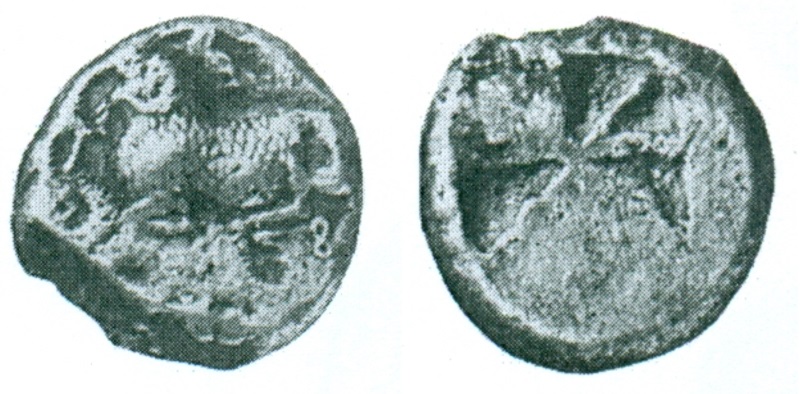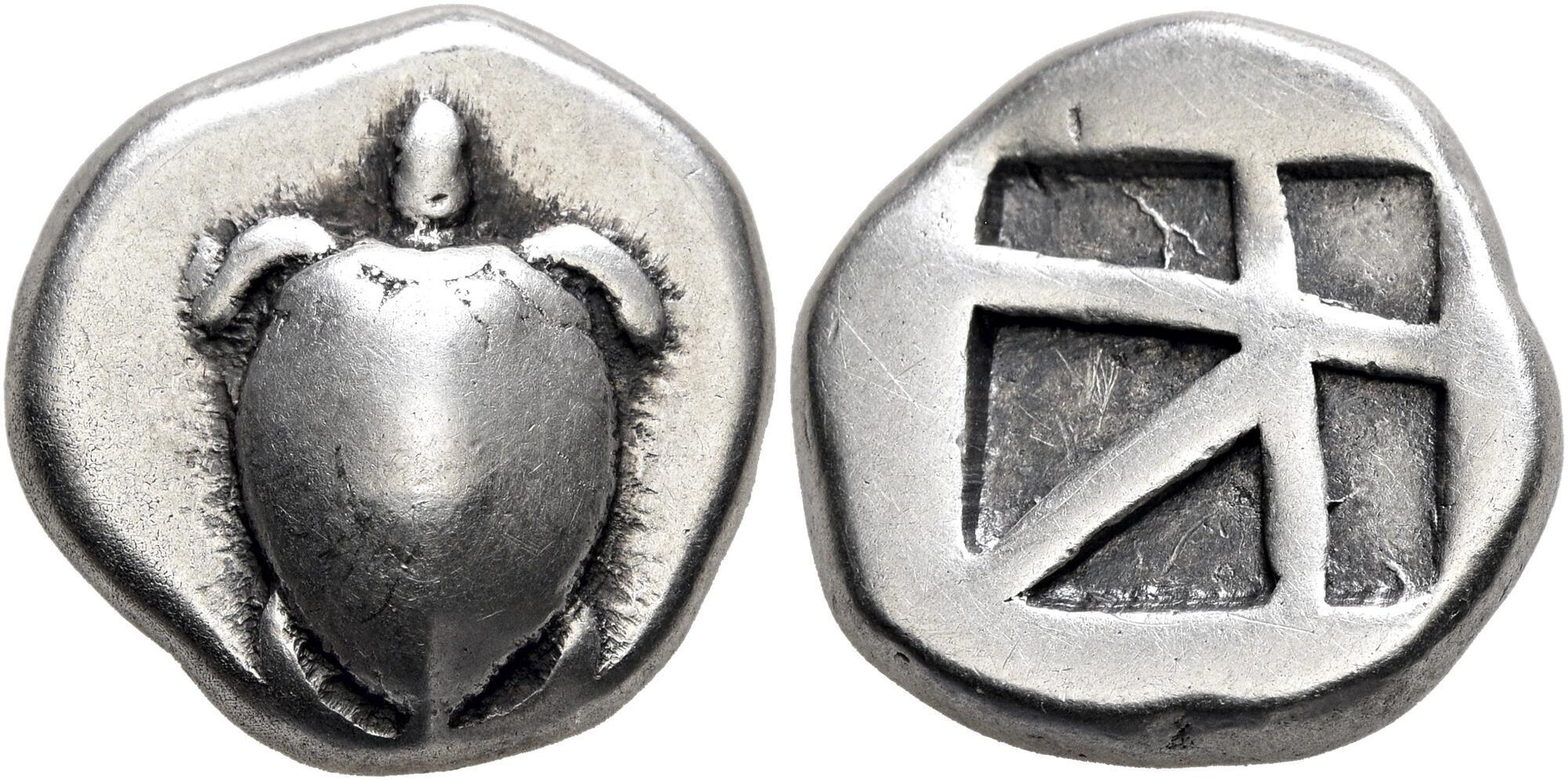530 BCE - 500𐠁𐠄𐠳 ('E-u-fe' in Cypriot syllabic script)
Overstriking coin
Salamis_over_Aegina_Gorny_&_Mosch,_134,_1503.jpg
[1]
|
|
Sale(s)Sale(s) ᵖ:
|
Gorny & Mosch, 134, 11 Oct. 2004, 1503
|
|
|
|
Description
| ObverseInscription or printing placed on the obverse.:
|
𐠁𐠄𐠳 ('E-u-fe' in Cypriot syllabic script) (Cypriot) Ram recumbent to left
|
ReverseInscription or printing placed on the reverse.:
|
No type.
|
Mint and issuing power
Chronology
| FromIdentifies the initial date in a range assigned in a numismatic context. 530 BCE toIdentifies the final date in a range assigned in a numismatic context.. 500
|
Archaic until 480 BC  periodTime period of the numismatic object. periodTime period of the numismatic object.
|
Physical description
MetalThe physical material (usually metal) from which an object is made.: Silver 
|
WeightWeight of the numismatic object (in grams). in grams: 11.2711.27 g <br />11,270 mg <br />
|
DenominationTerm indicating the value of a numismatic object. Examples: tetradrachm, chalkous, denarius.: double siglos 
|
|
|
|
StandardStandard.: Persian
|
References
| Coin referenceReference of the Coin:
|
Destrooper-Georgiades 2013, p. 21, n° 23
|
Coin series referenceReference to coin series study:
|
BMC Cyprus1BMC Cyprus, p. 46, n° 1-4, Tziambazis 20022Tziambazis 2002, n° 95, Zapiti - Michaelidou 20083Zapiti - Michaelidou 2008, n° 4, Destrooper-Georgiades 20134Destrooper-Georgiades 2013, p. 21, n° 23
|
| Coin series web referenceCoin series web references:
|
|
Description
| ObverseInscription or printing placed on the obverse.:
|
Turtle.
|
ReverseInscription or printing placed on the reverse.:
|
Incuse square.
|
Mint and issuing power
| MintIdentifies the place of manufacture or issue of a numismatic object. ᵖ:
|
Aegina
|
Ancient regionAncient region. ᵖ
|
Attica
|
Modern countryModern country: Greece
|
AuthorityIdentifies the authority in whose name (explicitly or implicitly) a numismatic object was issued. ᵖ:
|
|
Chronology
| FromIdentifies the initial date in a range assigned in a numismatic context. 500 BCE toIdentifies the final date in a range assigned in a numismatic context.. 460 BCE
|
Archaic until 480 BC  periodTime period of the numismatic object. periodTime period of the numismatic object.
|
Physical description
| DenominationTerm indicating the value of a numismatic object. Examples: tetradrachm, chalkous, denarius. ᵖ:
|
stater 
|
StandardStandard. ᵖ:
|
Aeginetic
|
References
References
- ^ Hill, George Francis (1904), A Catalogue of the Greek coins in the British Museum, vol XX : Cyprus, London, cxliv, 119 p., xxvi pl.,
- ^ Tziambazis, Elias (2002), A catalogue of the coins of Cyprus: from 560 B.C. to 1571 A.D., Larnaca, 89 p.
- ^ Zapiti, Eleni - Michaelidou, Lefki (2008), Coins of Cyprus : from the collection of the Bank of Cyprus Cultural Foundation, Nicosia, Bank of Cyprus Cultural Foundation, 329 p.
- ^ Destrooper-Georgiades, A. (2013), "Monnaies chypriotes surfrappées des cités-royaumes," in Demetrios Michaelides (ed.), Epigraphy, numismatics, prosopography and History of Ancient Cyprus. Papers in honour of Ino Nicolaou, Studies in Mediterranean Archaeology and Literature PB 179, Uppsala, p. 9-40.
- ^ Hoover, Oliver D. (2010), The Handbook of Greek Coinage Series, volume 6 : handbook of coins of the islands: Adriatic, Iionian, Thracian, Aegean, and Carpathian seas (excluding Crete and Cyprus), sixth to first centuries BC, Lancaster, 358 p.
- ^ Meadows, Andrew (forthcoming), Greek coinage in the Persian Empire: The Malayer 1934 Hoard (IGCH 1790).

